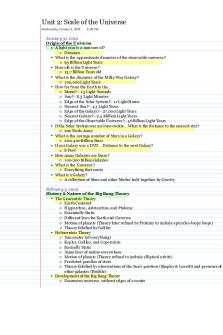Lab 12 - the expansion of the universe and hubble\'s law PDF

| Title | Lab 12 - the expansion of the universe and hubble\'s law |
|---|---|
| Course | Astronomy Laboratory |
| Institution | San Francisco State University |
| Pages | 1 |
| File Size | 63.1 KB |
| File Type | |
| Total Downloads | 70 |
| Total Views | 143 |
Summary
the expansion of the universe and hubble's law...
Description
Lab 12: The Expansion of the Universe and Hubble’s Law Part 1 1) A popular model for the universe was static. It means that the universe is and always has been the way we see it now and hasn’t changed much. 2) When galaxies are redshifted, they are moving away from us. 3) Slipher said that the redshifted galaxies are moving at high speeds. Lemaître proposed the ide that the universe is expanding and that’s why the galaxies are moving away from us. Alexander Friedman also found the same conclusion. 4) When Hubble and Humason compared the distances and redshifts together, he discovered that the farther the galaxy was, the faster us was moving away from us.
Part 2 1) Lemaître called this point a primeval atom also known as the cosmic egg. This event was known as The Big Bang. 2) The farther away something is, the farther in the past we see it. 3) They used a radio telescope. 4) Yes, because the rubber ruler represents space and when it is stretches out, space is expanding. The tick marks are 2 galaxies that were once closer together, but because space is expanding, they are farther apart. Galaxies aren’t actually moving away from each other, but the space between them is expanding. 5) The age of the universe is 13.82 billion years. It is three times larger than the Earth.
Part 3 1) Hubble’s Law is that the further a galaxy is away, the faster it’s flying away from us. 2) Brian Cox uses a bread and raisin example. To make bread, there needs to be dough. Raisins are mixed into the dough and when it’s baking in the oven, the dough expands to become bread and the space between the raisins also expands. 3) There is no center of the universe. 4) The Hubble constant is 42 miles/second/ 3 million light years. It means that objects will be moving 42 miles per second if you go 3 million light years away. If you go twice as far (6 million light years), then objects will also move twice as much (84 mi/s)...
Similar Free PDFs

A Corner of the Universe
- 73 Pages

The nature and functions of the law
- 78 Pages

The Law of the Tenement
- 6 Pages

The Law of Alibi
- 3 Pages

The Elegant Universe - Brian Green
- 190 Pages

Life in the Universe Notes
- 52 Pages

The problems of the first law
- 67 Pages

The Fusion of Law and Equity
- 4 Pages
Popular Institutions
- Tinajero National High School - Annex
- Politeknik Caltex Riau
- Yokohama City University
- SGT University
- University of Al-Qadisiyah
- Divine Word College of Vigan
- Techniek College Rotterdam
- Universidade de Santiago
- Universiti Teknologi MARA Cawangan Johor Kampus Pasir Gudang
- Poltekkes Kemenkes Yogyakarta
- Baguio City National High School
- Colegio san marcos
- preparatoria uno
- Centro de Bachillerato Tecnológico Industrial y de Servicios No. 107
- Dalian Maritime University
- Quang Trung Secondary School
- Colegio Tecnológico en Informática
- Corporación Regional de Educación Superior
- Grupo CEDVA
- Dar Al Uloom University
- Centro de Estudios Preuniversitarios de la Universidad Nacional de Ingeniería
- 上智大学
- Aakash International School, Nuna Majara
- San Felipe Neri Catholic School
- Kang Chiao International School - New Taipei City
- Misamis Occidental National High School
- Institución Educativa Escuela Normal Juan Ladrilleros
- Kolehiyo ng Pantukan
- Batanes State College
- Instituto Continental
- Sekolah Menengah Kejuruan Kesehatan Kaltara (Tarakan)
- Colegio de La Inmaculada Concepcion - Cebu







